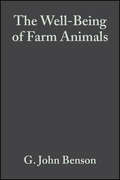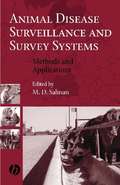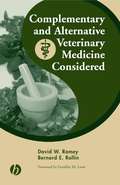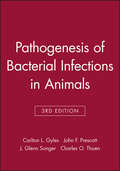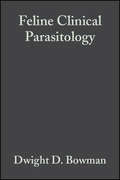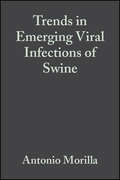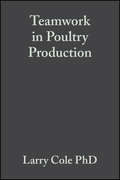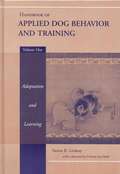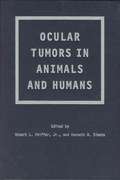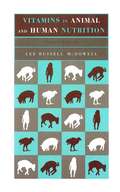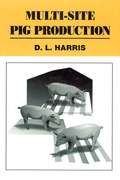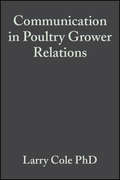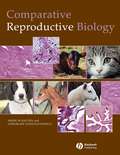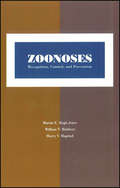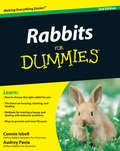- Table View
- List View
Horse Stable and Riding Arena Design
by Eileen Fabian WheelerWhether you are a veterinarian consulting on how to maintain the integrity of the grain and water in the horse'e newly-built stall; or the agricultural engineer who has been asked to design a new state-of-the-art equine shelter; or an animal scientist or horse owner who simply wants the latest, safest, and most up-to-date information on manure management - this book will fulfill your needs! This handy, user-friendly guide answers some of the toughest questions about equine shelters. Covering everything from preferred building materials such as lighting to flooring in the horse's primary shelter to design and management of a riding arena, this practical reference will guide the reader every step of the way. This practical reference is filled with clear, user-friendly design illustrations and information on ventilation, manure management, fence planning, fire safety, feed storage, bedding requirements, dust control systems, and a myriad of detailed information designed for the comfort, safety, and health of your horse in areas where cold weather is a factor.
Global Livestock Health Policy: Challenges, Opportunties and Strategies for Effective Action
by Robert F. KahrsGlobal Livestock Health Policy is designed to provide an understanding of the complexities of national and subnational animal and public health policies and how those policies impact domestic livestock industries. These policies shape domestic disease control programs, international trade, and food safety efforts. This book offers public policy makers and animal health officials in government and industry a foundation on which to institute scientifically sound national and subnational animal health programs; solidify infrastructures; enhance communication between legislators, regulators, and affected parties; and expedite international agreements for safe worldwide movement of animals and animal products in a global free market economy. Organized in eight free standing chapters which include case studies, a glossary and an epilogue, this arrangement leads readers progressively through the events and decisions underlying the present US and global animal health policy status, lays out challenges facing the US and other nations, describes the components of a credible and competitive animal health infrastructure, and puts forward strategies for achieving policies that are adaptable to global and domestic dynamics while addressing the multiple issues and interests bearing on animal health, animal welfare, and food safety. The case studies contain background information and questions for group discussions. The book is intended for use by animal health officials; agribusiness leaders; commodity groups; financial institutions; legislators and their staffs; importers and exporters of animals, animal products, biologics and pharmaceuticals; leadership of the regulatory, academic and diagnostic sectors of the agricultural and veterinary communities; consumers; or anyone else interested in protection, production, processing, and distribution of animals and related products.
The Well-Being of Farm Animals: Challenges and Solutions
by G. John Benson Bernard E. RollinThe Well-Being of Farm Animals: Challenges and Solutions is the first title in Blackwell Publishing Professional's groundbreaking series Issues in Animal Bioethics. This important book examines the ethical and economic importance of production animal well-being and pain management—topics of increasing concern to consumers. The Well-Being of Farm Animals: Challenges and Solutions offers veterinarians, veterinary and agriculture students, animal scientists, and food animal producers both practical methods to enhance farm animal well-being, and greater understanding of the theoretical underpinnings of those methods. With a variety of perspectives from respected experts and specialists, this book conveys new research findings and promotes valuable discourse on critical issues. Most importantly, editors Benson and Rollin provide feasible instruction to put theory into practice. The theories and applications presented in this book are likely to be legislated in the future. Therefore, it is important for veterinarians in production animal medicine to keep abreast of the latest issues in promoting animal well-being, and implement sound animal welfare methods every day. The Well-Being of Farm Animals: Challenges and Solutions provides the information veterinarians need to do both.
Animal Disease Surveillance and Survey Systems: Methods and Applications
by M. D. SalmanThis valuable text presents methods and techniques for conducting an animal disease surveillance program, and developing an animal health moitoring system. The text is a 'recipe book' for these techniques as it explains modern techniques, while emphasizing the fundamentals and principles of using these techniques.The book is targeted to epidemiologists and other animal health authorities who are working in national, regional, and international programs. The book can be used as a text for professional and postgraduate training curricula. This text will be of value in veterinary epidemiology and regulatory medicine, where there is need for a concise collection of material on animal disease monitoring, surveillance, and reporting strategies. This need arises from a new era of international trade regulations based on animal diseases, new demands for accountability in utilization of research funds, and calls for prioritizing and economically justifying animal health regulatory and diagnostic activities.
Infectious Diseases of Wild Mammals
by Elizabeth S. Williams Ian K. BarkerInfectious Diseases of Wild Mammals, Third Edition presents the latest information on the diagnosis and treatment of infectious disease in both free-ranging and captive wild mammals. Editors Elizabeth Williams and Ian Barker have recruited 71 contributors, all noted experts in their fields, to update this new edition. This reference provides valuable information on each disease, including Etiology History Distribution Epidemiology Clinical signs Pathology Immunity Diagnosis Treatment Control This latest edition is a leading reference book for Wildlife biologists, managers, and rehabilitators Biology students Conservationists Public health workers
Complementary and Alternative Veterinary Medicine Considered
by David W. Ramey Bernard E. RollinComplementary and Alternative Veterinary Medicine Considered is a book that belongs in your veterinary library. If you are a veterinarian wondering if you should incorporate complementary and alternative veterinary medicine (CAVM) into your practice, if you have recently hired an associate eager to try such things as acupuncture or homeopathy, or if you have clients asking you about chiropractic, herbal, or magnetic field therapy for their pets, you’ll want to understand the history, science and ethics behind such therapies. In its 2001 Guidelines for Complementary and Alternative Medicine, the American Veterinary Medical Association (AVMA) recognizes the growing interest in CAVM, and encourages the critical examination of these therapies using the scientific method. Following the AVMA’s lead on this subject, Complementary and Alternative Veterinary Medicine Considered thoroughly examines a variety of CAVM therapies and asks important questions regarding alternative treatments. For example, is acupuncture effective in pain relief? What is homeopathy? What is the history behind chiropractic? What does the research say (and not say) about various CAVM modalities? And, just as importantly, what are the ethical and regulatory considerations concerning such therapies? This book has the answers to those questions and more. Complementary and Alternative Veterinary Medicine Considered will help practicing veterinarians to make informed decisions about specific CAVM therapies. This text evaluates various prevalent therapies, and will give veterinarians the ethical and scientific bases they need to make sound decisions regarding CAVM therapies Coverage includes but is not limited to: Acupuncture and acupressure; Energy medicine; Manual therapy (chiropractic); Manual therapy (massage); Magnetic and electromagnetic therapy; Laser and light therapy; Homeopathy; and Herbal therapy.
Pathogenesis of Bacterial Infections in Animals
by Carlton L. Gyles John F. Prescott J. Glenn Songer Charles O. ThoenThis much-anticipated third edition again consolidates the knowledge of more than twenty experts on pathogenesis of animal disease caused by various species or groups of bacteria. Emphasizing pathogenic events at the molecular and cellular levels, the editors and contributors place these developments in the context of the overall picture of disease. Pathogenesis of Bacterial Infections in Animals, Third edition, updates and expands the content of the second edition and includes cutting-edge information from the most current research. Comments on previous editions: "...highly recommended." --The Veterinary Record "...a comprehensive, complete and easy-to-use source of information." --Veterinary Microbiology "...recommended for graduate students and specialists in microbiology, pathology and infectious disease." --U.S. Animal Health Association Newsletter "...a wonderful book." --Journal of the American Veterinary Medical Association "...highly recommended." --The Cornell Veterinarian Graduate students, faculty, researchers, and specialists in microbiology, pathology, and infectious diseases will benefit from this highly-detailed and expanded edition of a popular and well-read veterinary text.
Hand-Rearing Birds
by Laurie J. Gage Rebecca S. DuerrHand-Rearing Birds will provide the reader with a guide to the best methods of hand rearing all major species of birds. The book is broken into two sections. The first section covers standard hand raising methods and equipment, while the second provides individual chapters devoted to many major avian species. This book will be an invaluable reference for shelter veterinarians, zoo veterinarians, avian veterinarians, aviculturists, bird enthusiasts, and conservationists alike.
Feline Clinical Parasitology
by Dwight D. Bowman Charles M. Hendrix David S. Lindsay Stephen C. BarrAlthough there are books available dealing with canine parasitology, there is at present no book detailing parasites that offers clinical information specific to felines. Cats differ significantly from dogs in their parasitic infections and infestations. Although dogs and cats do share a few parasites, the vast majority of the parasites of these pets are specific to either cats or dogs, not to both. This must-have reference offers an in-depth examination of feline parasites. Topics covered include parasite identification, history, geographic distribution, pathogeneisis, epidemiology, zoonosis, diagnosis, treatment, control, and prevention. Because of the immense worldwide popularity of cats and due to the amount of travel undertaken by cats and their owners, the authors have produced a book that is international in scope. Consequently, this exhaustive reference has strong appeal to practitioners and veterinary parasitologists in North America and around the world.
Trends in Emerging Viral Infections of Swine
by Antonio Morilla Kyoung-Jin Yoon Jeffrey J. ZimmermanTrends in Emerging Viral Infections of Swine includes sections on global trade, vaccination regimens against new and emerging viruses, epidemiology and control, as well as significant new outbreaks like the West Nile virus. A contributor to Diseases of Swine, 8th edition, Dr. Zimmerman has selected three additional editors with international expertise.
Teamwork in Poultry Production: Improving Grower and Employee Interpersonal Skills
by Larry ColeToday more than ever before in the history of the poultry industry there is a concerted effort to improve the working relationship between the grower and the integrator. Teamwork in Poultry Production picks up wher Larry Cole's previous book, Communication in Poultry Grower Relations, left off. While the first book concentrated on organizational improvement, this book focuses on the specific interpersonal skills needed in the industry to create a synergistic working relationship-a topic which, until now, has been largely ignored. Written in a down-to-earth training style, this book: 1 Details the interpersonal and communication issues that determine the success of the employee-grower working relationship 2 Outlines the responsibilities of both the contract grower and the company employee, providing a detailed description of what each party can do to improve the working relationship on the farm 3 Creates a behavioral blueprint that can be easily implemented by the entire grower-employee network 4 Serves as the resource for ongoing training efforts with employees and growers
Handbook of Applied Dog Behavior and Training, Adaptation and Learning
by Steven R. LindsayTwenty-five years of study and experience went into the making of this one-of-a-kind reference. Veterinarians, animal scientists, dog owners, trainers, consultants, and counsellors will find this book a benchmark reference and handbook concerning positive, humane management and control of dogs. Reflecting the author's extensive work with dogs, this book promises thorough explanations of topics, and proven behavioural strategies that have been designed, tested, and used by the author. More than 50 figures and tables illustrate this unique and significant contribution to dog behaviour, training, and learning.
Ocular Tumors in Animals and Humans
by Robert L. Peiffer Kenneth B. SimonsThe application of evidence-based veterinary medicine (EBVM) can assist in improving and optimising the diagnosis, prognosis, control, treatment and ultimately the welfare of animals. It can also provide the user with a methodology for appropriate, patient orientated life-long, self-directed, learning. To practise evidence-based veterinary medicine we require a range of skills that we may not have. This book will explain what evidence-based veterinary medicine is and show how it can be applied to veterinary practice to improve the quality of care for patients and provide informed choices for owners. It will provide the reader with a toolkit of skills necessary to practise evidence-based veterinary medicine. The authors explain how to: · Transform information needs into a series of clinical questions that can be answered · Search for best available external evidence · Critically appraise the evidence for its validity and importance · Apply the results in clinical practice · Understand the process of diagnosis and use of clinical diagnostic decision support systems · Perform a decision analysis This book is aimed at practitioners but will be of interest to veterinary surgeons at any stage of their training or career wishing to learn about EBVM. The authors are responsible for devising and teaching an EBVM course at the veterinary school at Cambridge. Dr Peter Cockcroft, Clinical lecturer, Department of Clinical Veterinary Medicine, University of Cambridge.
Vitamins in Animal and Human Nutrition
by Lee Russell McDowellVitamins in Animal and Human Nutrition contains concise, up-to-date information on vitamin nutrition for both animals and humans. The author defines these nutrients and describes their fascinating discovery, history and relationship to various diseases and deficiencies. Discussion of vitamins also includes their chemical structure, properties and antagonists; analytical procedures; metabolism; functions; requirements; sources; supplementation and toxicity. Vitamin-like substances, essential fatty acids and vitamin supplementation considerations are also examined. This book will be useful worldwide as a textbook and as an authoritative reference for research and extension specialists, feed manufacturers, teachers, students and others. It provides a well-balanced approach to both animal and clinical human nutrition and compares chemical, metabolic and functional aspects of vitamins and their practical and applied considerations. A unique feature of the book is its description of the implications of vitamin deficiencies and excesses and the conditions that might occur in human and various animal species.
Multi-Site Pig Production
by D. L. HarrisMulti-site Pig Production is the first comprehensive description of the most profound changes that have occurred in swine production methodology in many years. Dr Harris is singularly qualified to write this book because he has played a pivotal role in the development of multi-site rearing techniques that are being applied throughout the world. This book provides final definition for a variety of terms being used to describe swine production methods. A standardised nomenclature facilitates more accurate future interactions between participants in swine production systems that involve multiple sites, buildings, and rooms with different age groups and functions.
Communication in Poultry Grower Relations: A Blueprint to Success
by Larry ColeCommunication in Poultry Grower Relations shows a process used to continuously improve the working relationship between integrators and their growers. A special feature is the "how to" format in which this book details the relationship process so a company and its growers can implement the procedures discussed. The book also provides a comprehensive discussion on the dynamics associated with corporate culture changes. The reader will learn how to manage the resistance associated with each of the five phases of change to successfully implement the improvements in the company-grower working relationship.
Biology, Medicine, and Surgery of South American Wild Animals
by Zalmir S. Cubas Murray FowlerBiology, Medicine and Surgery of South American Wild Animals examines the medicine and treatment of animals specific to South America. It discusses topics dealing with diseases and biology topics. In addition, the animals studied are broken down into family and genus, using both English and Spanish names. The book is liberally illustrated and contains references for further reading as well as the contributions of regional experts on the animals covered.
Handbook of Applied Dog Behavior and Training, Etiology and Assessment of Behavior Problems
by Steve LindsayHandbook of Applied Dog Behaviour and Training, Volume two: Etiology and Assessment of Behaviour Problems is the definitive reference for dog trainers, behaviourists, breeders and veterinarians. Coupled with Volume one, this text provides theoretical and practical framework for understanding the development and treatment of dog behaviour problems. Topics covered include Fear, anxiety and phobias, Separation-related problems, Hyperactivity, and Dominance, territorial, and fear-related aggression. The focus is to present and evaluate the relevant applied and scientific literature, and to highlight what remains to be learned, while the author introduces alternative ways for analysing and understanding the etiology of dog behaviour problems.
Horse Health and Nutrition For Dummies
by Audrey Pavia Kate Gentry-RunningWant to know the best ways to care for your horse? Horse Health and Nutrition For Dummies gives you up-to-the-minute guidance on keeping horses healthy at all stages of life. It provides the latest information on equine nutrition and healthcare, explaining how your horse’s body functions and how to keep it in good working order. Packed with practical advice on equine first aid and alternative therapies, this completely practical, plain-English guide explains exactly what to feed your four-legged “hayburner” and how much. You’ll find out what kind of preventive care is vital to keeping your horse in good physical shape and how to recognize signs of illness when things go wrong. You’ll get the low-down on the diseases and conditions most likely to plague the domestic horse and find help in deciding whether to treat problems yourself or call the vet. Discover how to: Manage your horse’s diet House your horse safely and comfortably Tend to the daily details of horse care Examine coat, eyes, hooves and manure Identify, control, and prevent equine diseases Understand links between horse behavior and health Practice good horse nutrition Grow your own horse food Cover horse-health-care costs Breed your horse Care for pregnant mares and newborns A healthy horse is a happy horse. Keep your horse fit with a little help from Horse Health and Nutrition For Dummies, and you’ll be happy too!
Alternative Health Practices for Livestock
by Thomas Morris Michael KeiltyThe idea that current methods of food production are not sustainable in the long-term is a controversial topic. This book provides information that will advance a form of livestock production that meets the long- and short-term goals of human food production, minimizing degradation of natural resources. Important concerns regarding food safety, particularly antibiotic and chemical residues in meat, milk and other livestock foods, have stimulated renewed interest in alternative methods of promoting livestock health. Alternative Health Practices for Livestock is the first compilation of its kind for veterinarians, agriculture extension educators and livestock producers. It provides a well-referenced overview of some of the alternative livestock practices currently being examined. Key Features: A much needed information source on alternative health for large animals Contributions from veterinarians, farmers, extension educators and university professors Discusses the necessity for more validated scientific assessments of alternative and herbal therapies in livestock production Includes chapters on ways to promote alternative methods of health care for livestock, including steps to obtain research funding.
Hand-Rearing Wild and Domestic Mammals
by Laurie J. GageVeterinarians, technicians and wildlife caregivers are often called upon to have expertise in raising infant mammals. This book provides clear guidance to raising and caring for a wide variety of domestic, farm, wildlife, and zoo mammals from birth to weaning. Over thirty veterinary technicians, wildlife specialists, and veterinarians from around the world have contributed their expertise to this useful book that covers over 50 mammalian species. Some of the topics covered in each chapter of this book include: * Assessment of the neonate * Specialised equipment * Expected weight gains * Formula selection and preparation * Weaning techniques * Housing * Common medical problems Detailed chapters are devoted to the following animals: * Domestic animals: puppies, kittens, ferrets, sugar gliders and rabbits * Farm animals: foals, kids, llamas and piglets * Wildlife: squirrels, opossums, raccoons, rabbits, deer, foxes, bears, bats, and hedgehogs * Zoo animals: ungulates, non-domestic equids, exotic felids, polar bears, elephants, rhinoceroses, macropods, pinnipeds, large and small primates, lemurs and sloths Dr Laurie Gage is well known for her work and expertise in the rearing of seals, sea lions and walruses and has experience in rearing many other mammalian species.
Comparative Reproductive Biology
by Heide Schatten Gheorghe M. ConstantinescuWhen considering the physiological systems of the body, the degree of species variation within the reproductive system compared to other systems is remarkable. Furthermore, it is essential that researchers, educators, and students alike remain aware of the fundamental comparative differences in the reproductive biology of domestic species. Written by renowned scientists in their respective fields, Comparative Reproductive Biology is a comprehensive reference on the reproductive systems of domestic species. The book offers both broad and specific knowledge in areas that have advanced the field in recent years, including advances in cell and molecular biology applied to reproduction, transgenic animal production, gender selection, artificial insemination, embryo transfer, cryobiology, animal cloning and many others. This seminal text includes topics in animal reproduction that are usually only found as part of other books in animal science such as anatomy, histology, physiology, radiology, ultrasonogrophy, and others. Comprehensive reference of the reproductive systems of domestic species Written by a team of top researchers Richly illustrated throughout, including 12 pages of color images
Zoonoses: Recognition, Control, and Prevention
by Martin E. Hugh-Jones William T. Hubbert Harry V. HagstadProvides expanded information which includes sections on historic background, current principles, and anticipated future changes, and consideration of the latest knowledge of human and veterinary medicine in the field of zoonoses. A chapter summary and selected bibliography for each of the first six chapters.
Rabbits For Dummies
by Connie Isbell Audrey PaviaYour hands-on guide to being a responsible rabbit owner Want to raise a happy, healthy bunny? This practical guide gives you everything you need to know to successfully adopt, nurture, live with, and love a rabbit. From choosing a rabbit and preparing its home to training, healthcare, and having fun with your bunny, you get a wealth of expert tips that will have your rabbit (and you) hopping with joy! Jump into bunny basics — decide whether a rabbit is the right pet for you, discover the different breeds, and find out the best places to adopt your bunny Take care of creature comforts — from housing and grooming to feeding and healthcare, provide the best care for your friend Practice bunny "psychology" — understand bunny body language and sounds, handle behavior issues, and train your bunny to do tricks and use the litter box Enjoy the wonderful world of rabbits — play games with your bunny, join clubs and organizations, show your rabbit, and make traveling with bunny easy Open the book and find: Informative photos and illustrations Detailed breed descriptions How to think like a rabbit Tips for handling bad bunny behavior The latest on organic cuisine and homegrown feeding options Games to play with your rabbit How to live with an indoor bunny (which is recommended!) Ten signs that require emergency action A bunch of bunny resources — from rescue groups to registries to Web sites
Rabbits For Dummies
by Connie Isbell Audrey PaviaYour hands-on guide to being a responsible rabbit owner Want to raise a happy, healthy bunny? This practical guide gives you everything you need to know to successfully adopt, nurture, live with, and love a rabbit. From choosing a rabbit and preparing its home to training, healthcare, and having fun with your bunny, you get a wealth of expert tips that will have your rabbit (and you) hopping with joy! Jump into bunny basics — decide whether a rabbit is the right pet for you, discover the different breeds, and find out the best places to adopt your bunny Take care of creature comforts — from housing and grooming to feeding and healthcare, provide the best care for your friend Practice bunny "psychology" — understand bunny body language and sounds, handle behavior issues, and train your bunny to do tricks and use the litter box Enjoy the wonderful world of rabbits — play games with your bunny, join clubs and organizations, show your rabbit, and make traveling with bunny easy Open the book and find: Informative photos and illustrations Detailed breed descriptions How to think like a rabbit Tips for handling bad bunny behavior The latest on organic cuisine and homegrown feeding options Games to play with your rabbit How to live with an indoor bunny (which is recommended!) Ten signs that require emergency action A bunch of bunny resources — from rescue groups to registries to Web sites


